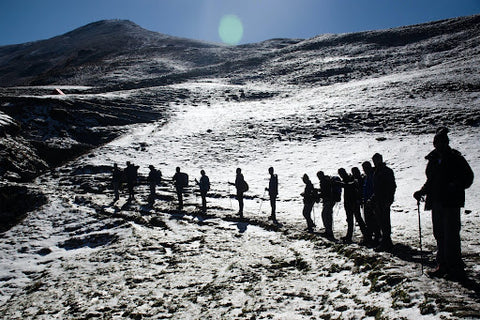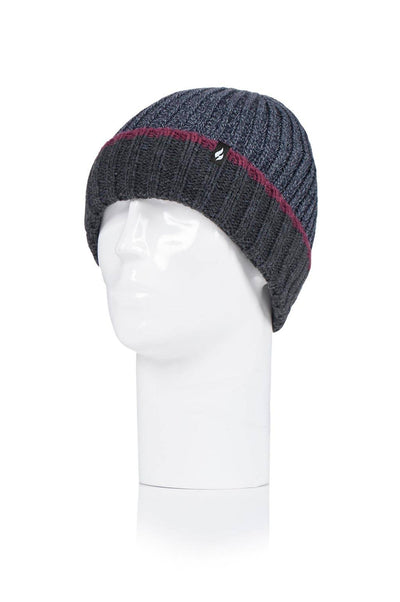Winter hiking can be a beautiful and rewarding experience, but it also comes with its own set of challenges. Snow-covered trails, freezing temperatures, and limited daylight hours require hikers to be well-prepared with the right gear. In this guide, we will explore the essential winter hiking gear to keep you warm, safe, and comfortable during your outdoor adventures and highlight:
- The importance of choosing the best winter gear
- The essentials for outdoor adventures
- How to stay hydrated and sustained during your winter hike, and
- Emergency and survival gear tips
Alt text: A person exploring an icy cave on a winter hike
What Is the Importance of Proper Winter Hiking Gear?
When it comes to winter hiking, having the right gear is crucial for both safety and comfort. The cold temperatures and slippery conditions can pose serious risks if you are not adequately equipped. Proper winter hiking gear is designed to protect you from the elements and provide essential features to navigate through challenging terrain.
Winter hiking is an exhilarating outdoor activity that allows you to experience the beauty of nature in its frozen form. However, it also comes with its own set of challenges. The biting cold can quickly drain your body heat, and the icy trails can be treacherous. This is where proper winter hiking gear comes into play, acting as your shield against the harsh winter conditions.
What Role Does Winter Hiking Gear Play in Safety and Comfort?
Winter hiking gear plays a vital role in keeping you safe and comfortable on the trails. Insulated clothing and accessories help regulate your body temperature and prevent hypothermia. Imagine trekking through a snowy forest, surrounded by a winter wonderland.
With the right gear, you can stay warm and cozy, enjoying the beauty of your surroundings without worrying about frostbite or shivering uncontrollably.
Sturdy boots provide traction on icy surfaces, reducing the risk of slips and falls. These boots are specially designed with durable soles that grip the ground, allowing you to confidently navigate through slippery terrain. They also provide ankle support, preventing sprains and injuries. With each step, you can feel the stability and confidence that comes from wearing the right footwear.
Additionally, specialized equipment such as trekking poles, snowshoes, and crampons enhance stability and prevent injuries. Trekking poles provide extra support and balance, especially when traversing steep slopes or crossing icy streams. Snowshoes distribute your weight over a larger surface area, preventing you from sinking into deep snow. Crampons, on the other hand, are metal spikes that attach to your boots, giving you the traction needed to conquer icy surfaces with ease.
What Are the Key Differences Between Summer and Winter Hiking Gear?
In winter, the main difference in hiking gear lies in insulation and traction. While summer hiking gear focuses on breathability and lightweight materials, winter gear prioritizes warmth and stability. Insulated jackets, pants, and baselayers help retain body heat, allowing you to stay warm even in freezing temperatures. These layers are designed to trap air close to your body, creating a barrier against the cold.
Boots play a crucial role in winter hiking gear. Unlike their summer counterparts, winter boots are heavily insulated and waterproof. They are equipped with features like Thinsulate insulation, which keeps your feet warm without adding bulk. The waterproofing ensures that your feet stay dry, even when trudging through slushy snow or crossing icy streams.
One of the most significant differences in winter hiking gear is the addition of crampons. These metal spikes attach to the soles of your boots, providing excellent traction on icy surfaces. They are essential for traversing steep slopes or icy trails, where a single slip could have serious consequences. With crampons, you can confidently tackle any icy obstacle that comes your way.
As you can see, proper winter hiking gear goes beyond just keeping you warm. It provides the necessary tools to navigate through challenging winter conditions safely. So, before embarking on your next winter hiking adventure, make sure you have the right gear to fully enjoy the beauty of the winter landscape while staying safe and comfortable.
Essential Winter Hiking Clothing
Dressing in layers is essential for winter hiking to regulate body temperature and manage moisture. The layering system consists of three key layers: baselayer, insulating layer, and outer shell.
When it comes to winter hiking, being prepared with the right clothing is crucial. The cold temperatures and unpredictable weather conditions can make or break your hiking experience. That's why understanding the basics of layering and choosing the right gear is essential.
Layering Basics for Winter Hiking
The baselayer is responsible for wicking away moisture from your body. It acts as a second skin, keeping you dry and comfortable throughout your hike. When choosing a baselayer, opt for moisture-wicking materials such as merino wool or synthetic fabrics. These materials are designed to pull sweat away from your skin, preventing you from feeling damp and chilled.
Next, the insulating layer provides warmth and insulation. This layer helps to trap heat close to your body, keeping you cozy even in freezing temperatures. Depending on the temperature and personal preference, you can choose between a fleece jacket or a down jacket. Fleece jackets are lightweight and breathable, making them ideal for moderate cold conditions. On the other hand, down jackets offer superior warmth and are perfect for extremely cold weather.
Finally, the outer shell is your ultimate defense against wind, snow, and rain. This layer acts as a barrier, protecting you from the elements. When selecting an outer shell, look for a waterproof and breathable jacket and pants. These will keep you dry and shielded from rain or snow, while still allowing moisture to escape, preventing you from feeling clammy.
Choosing the Right Winter Hiking Boots
Investing in a pair of high-quality winter hiking boots is crucial for a safe and enjoyable hike. Your feet are your foundation, and keeping them warm and dry is essential to prevent discomfort and injury.
When shopping for winter hiking boots, there are a few key features to consider. First and foremost, insulation is vital. Look for boots that have adequate insulation to keep your feet warm in the coldest temperatures. The level of insulation you need will depend on the conditions you plan to hike in, so make sure to choose accordingly.
Waterproofing is another important factor to consider. Winter hikes often involve walking through snow or encountering wet conditions, so having boots that can keep your feet dry is essential. Look for boots made with waterproof materials and sealed seams to ensure maximum protection.
Lastly, ankle support is crucial for navigating uneven terrain and preventing injuries. Look for boots that provide good ankle support to reduce the risk of sprains or twists. Additionally, make sure to break in your boots before heading out on a challenging winter hike. This will help prevent discomfort and blisters, allowing you to fully enjoy your outdoor adventure.
Gloves, Hats, and Scarves: Small but Crucial Gear
While it's easy to focus on the bigger items like jackets and boots, don't overlook the importance of small but crucial gear like gloves, hats, and neckwarmers. These accessories play a significant role in keeping your extremities protected and maintaining overall body warmth.
When it comes to gloves or mittens, insulation and dexterity are key. Look for gloves or mittens that offer adequate insulation to keep your hands warm, but also allow you to easily handle hiking poles or use your fingers when needed.
Don't forget about your head and neck! Heat escapes from your head, so wearing a hat is essential to prevent heat loss. Opt for a hat that covers your ears to provide extra warmth and protection. Additionally, wearing a scarf or neck gaiter can help keep your neck protected from cold winds, preventing heat from escaping and ensuring your overall comfort.
By paying attention to these small but crucial details, you can ensure that your winter hiking experience is not only safe but also enjoyable. So, before you hit the trails, make sure you have the right gear to keep you warm, dry, and comfortable throughout your adventure.

Navigating the Terrain: Winter Hiking Equipment
Winter hiking presents unique challenges, particularly in terms of navigating the terrain. The following equipment will help enhance stability and safety when hiking on snow-covered trails.
The Importance of Reliable Trekking Poles
Trekking poles provide stability and support on slippery or uneven terrain. They help distribute your weight and reduce strain on your knees. Look for poles with adjustable height and durable materials that can withstand harsh winter conditions.
Snowshoes and Crampons: When and Why to Use Them
Snowshoes and crampons are essential tools for winter hiking in icy or snowy conditions. Snowshoes prevent you from sinking into deep snow, distributing your weight and making it easier to walk. Crampons, on the other hand, provide traction on icy surfaces and steep slopes. Knowing when and how to use these tools can significantly improve your safety and enjoyment on winter hikes.
Keeping Nourished and Hydrated on Winter Hikes
Paying attention to nutrition and hydration is just as important during winter hikes as any other outdoor activity. The cold weather and physical exertion require you to fuel your body and stay adequately hydrated.
Winter Nutrition Tips for Hikers
Pack high-energy snacks such as nuts, trail mix, and energy bars to keep your energy levels up. Include foods that are easy to eat in cold temperatures, such as jerky, cheese, and dried fruits. Don't forget to consume enough calories to fuel your body's increased heat production during the hike.
Hydration Strategies for Cold Weather
Staying hydrated in winter can be challenging as the cold temperature reduces the sensation of thirst. Drink water regularly, even if you don't feel particularly thirsty, and add a powdered electrolyte. Consider using an insulated water bottle or bladder to prevent freezing and ensure your liquid intake remains accessible.
Emergency and Survival Gear for Winter Hiking
Being prepared for emergencies is crucial when venturing into the winter wilderness. Pack essential survival gear to ensure your safety in unexpected situations.
Essential First Aid Supplies for Winter Hikes
Carry a well-equipped first aid kit that includes items such as bandages, antiseptic wipes, pain relievers, and blister treatment. Additionally, familiarize yourself with basic first aid techniques, such as treating hypothermia and frostbite.
Tools and Equipment for Emergency Shelter
In the event of an unexpected situation or a sudden change in weather conditions, having emergency shelter supplies is vital. Carry a lightweight, compact emergency shelter, such as a bivy sack or an emergency blanket, to provide protection from the elements and retain body heat.

Conclusion
Having the right winter hiking gear is essential for a safe and enjoyable experience in the great outdoors. From insulating clothing to specialized equipment, each piece serves a purpose in protecting you from the cold and harsh winter conditions. By investing in quality gear and following the necessary safety precautions, you can confidently explore winter landscapes and embrace the beauty of nature.










